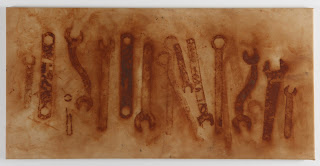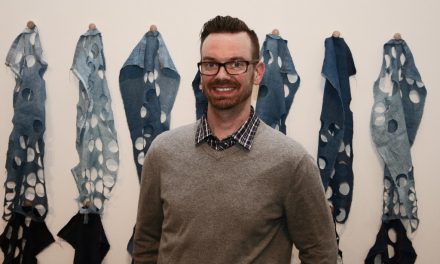Tools of the Trade: Fiber Art by Bette Levy
Review by Mary Margaret Sparks
Entire contents are copyright © 2012 Mary Margaret Sparks. All rights reserved.
When I heard that Bette Levy’s new exhibition at the Carnegie Center in New Albany included doilies and quilts, two of my favorite things, I had to see it for myself. Throughout my years in Louisville I have heard Bette Levy’s name mentioned, but this was my first time viewing an exhibit devoted to her work. She is a founding member of LAFTA (Louisville Area Fiber and Textile Artists), director of the Patio Gallery at the Jewish Community Center, and a member of PYRO Gallery.
 |
| Tools of the Trade I, 2011, Rusted cloth. Photography by Geoffrey Carr. |
Approaching the Carnegie Center for the opening reception, I was greeted by an array of doilies. Vintage doilies were wrapped around trees, signs, even the lamppost. This “doily bombing” was done by Levy and other local artists and sets the stage for the themes of the exhibition.
The majority of the work features sculptures of old tools with crochets. There are also a few quilted wall hangings, installations and canvases. I found the canvas pieces very interesting in their simplicity. The artist used varying degrees of rust on old tools to create outlines of those tools on the canvases. The pieces resembled cyanotypes but with a robust orange color in place of the bright blue. Being an artist who works with found objects, I experienced a feeling of “I can’t believe I didn’t think of that!” when seeing how Levy found meaning in common objects.
By using traditional materials and methods such as old tools, crochets and handkerchiefs, Levy reflects on her personal life and family origins. The natural and vintage goods used are beautifully composed into delicate and rustic sculptures. In most of the work, Levy combines old farming tools such as scythes, shears, and pulleys with crocheted pieces. This contrast of objects and ideas reflects Levy’s family origins. Talking with the artist I learned that historically, Jewish people couldn’t farm because they were not permitted to own land. Instead, they went into the clothing and textile business. Thus history directly informs the artist’s decision-making process.
 |
| Spring Doily, 2011, Truck spring, crocheted nylon cord and Paverpol. Photography by Geoffrey Carr. |
Levy uses linens and cords in her crocheted pieces. These textile elements transform a delicate crochet pattern into a sturdy rope-like structure, and the altering of materials adds another dimension to the sculptures. The work also addresses gender roles with the juxtaposition of a traditional masculine tool and an activity historically perceived as feminine. At first it seems that the two are incompatible, but in fact they are complementary. As Levy mentions in her artist statement, “Both forms of production require serious work ethic, planning and goal setting, repetitive hand movements and dependence on past knowledge and traditions.”
Both the farming tools and the crochets reflect on the past and cause viewers to ponder their own traditions and memories. Although Levy’s choice of materials was different than my own – my grandfather was a farmer and my grandmother a crochet artist – the pieces are universal enough for everyone to feel a connection with them. These sculptures are beautifully crafted with strict attention to detail. Even the nails on the wall were specifically chosen when hanging the work.
 |
| Pitchfork, 2011, Pitchfork, synthetic cord, Paverpol and crochet. Photography by Geoffrey Carr. |
One installation, titled Genealogy, was particularly compelling. It consisted of vintage handkerchiefs embroidered with the names of Levy’s female relatives from both of her parents. I learned from the artist that each handkerchief was distinct in design and represented a woman in the family’s origins. Some handkerchiefs had “unknown” or the same name listed twice. In Jewish culture, a child can be named after a deceased relative only. On handkerchiefs where the names are listed twice, a child passed away and the child born later was given the same name. This delicate yet striking installation is one of the more personal pieces in the exhibition. It’s a way for viewers to gain insight into the artist while also contemplating their own family origins.
I felt something of a personal connection with A Life and Times. The piece features envelopes from letters Levy wrote her parents over a ten-year period. It was fascinating that the letters had all been saved but also how the piece, again, represented relationships and history. The amount of letters written suggests a close relationship between the artist and her parents. They are illustrated and include beautifully calligraphy. This aesthetic beauty complements the beauty of the family relationship and again causes the viewers to ponder about their own family relationships.
 |
| A Life and Times, 2011. Photograph by Mary Margaret Sparks. |
This exhibition is worth a trip to New Albany. The sculptures are not just beautiful but also multi-dimensional, complex pieces that will challenge the way one views gender roles, tradition, and family. Tools of the Trade: Fiber Art by Bette Levy will be on display through April 28. The Carnegie Center for Art and History has free admission and is open Tuesday-Saturday, 10 a.m.-5:30p.m.
Tools of the Trade: Fiber Art by Bette Levy
Carnegie Center for Art and History
201 East Spring Street, New Albany, IN 47150




